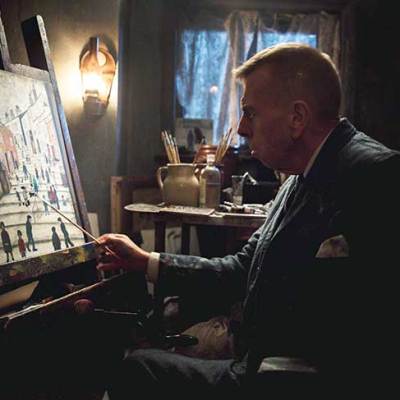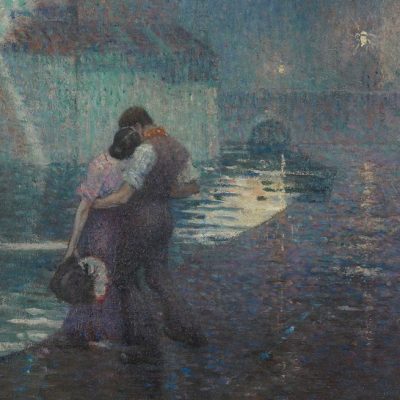Downstairs at Crane Kalman Gallery, in its exhibition celebrating the centenary of the painter Alan Lowndes (1921–78), one of his streetscapes is placed next to a street scene by L.S. Lowry. The pairing makes sense: Lowry is an artist to whom Lowndes has long been compared, and a recognised influence; both were from in or around Manchester (Trafford for Lowry, Stockport for Lowndes) and both sought in their painting to document the social life of the industrial north-west. When placed side by side, however, what becomes clear is not so much the continuity as the ways in which Lowndes veers away from his older contemporary. Lowry’s scene is organised around neat, methodical, yet strangely textureless lines: of the street, of the rows of houses that frame the composition, and of those distinctive outlines of almost fleshless bodies silhouetted against white background. By contrast, Lowndes’s Apsley Street, Stockport (1954), despite its own gestures towards geometric rigidity, comes across as all texture: the thick application of paint, in which blocks of colour – by turns warm and lugubrious – reveal themselves to contain rhythmic collisions of strokes and cuts so that the paint frays on the surface, and the viewer’s eye is increasingly drawn into impossible recessional spaces, just as the pale road in the foreground seems to melt into glowering shadow.
View from the Artist’s Window (1952), Alan Lowndes

The second thing you notice is that in Lowndes’s Stockport, the red brick of the industrial north-west is filtered through the palettes of the Mediterranean – its hue lies somewhere between antique terracotta and l’Estaque of Cézanne or Braque. This is less surprising than it might seem. Lowndes’s major artistic education (as for so many artists of his generation) came while serving during the Second World War. Apprenticed to a decorator after leaving school at 15, as a young soldier he was stationed in Italy, where his painterly eye was transformed not just by the frescoes, altarpieces and portraits he encountered in churches and museums, but its warmer light and richer colours of its sky and landscape. While Lowndes would always retain the ‘sociological’ gaze of the industrial realist painter (as the exhibition catalogue notes put it), the selection of his works on display at Crane Kalman invites us to see Lowndes through a more cosmopolitan lens: a self-portrait, and a female nude, are reminiscent of Soutine’s blend of fleshiness and emaciation, while View from the Artist’s Window takes the classic set-up of many a post-Impressionist work.
The Harbour, St. Ives (1956), Alan Lowndes

Despite Lowndes’s early Italian epiphany, the Stockport painting of 1954 still feels like a turning point among the works on display. The graininess of his earliest paintings is now integrated into bolder compositions, more voluptuous surfaces. And the spaces depicted in the paintings become more illusionistic, as if they are being constructed for several vantage points at once, yet still receding from view. Here another influence may be in play. From the early 1950s onwards, Lowndes spent an increasing amount of time in St Ives, then the home of two generations of British post-cubist artists – from Ben Nicholson and Barbara Hepworth to Peter Lanyon and Patrick Heron – and would live there between 1959 and 1970. Lowndes’s work remained resolutely figurative, and despite fraternising with his fellow artists he was never considered a ‘St Ives painter’ (and hence not able to benefit from the publicity that the label offered); nevertheless, in some paintings there are direct correlations with the work of his neighbours. A painting of St Ives Harbour (1956) shows a clear resemblance to Ben Nicholson’s depictions of the same scene, while French Crabber (1962), with its naive outline of a fishing boat against greyish sea and sky, is surely a homage to Alfred Wallis.
Love Near the Tripe Works (1963), Alan Lowndes

For all these various allusions and debts, however, the Crane Kalman exhibition shows that Lowndes’s painting remained something completely of his own. Works from the mid 1960s onwards place people going about their everyday habits – huddled, inexpressive bodies in monochrome, gambling, drinking, playing darts, hanging out washing, as well as in amorous embrace in the marvellously named Love Near the Tripe Works (1963) – within looming, often hallucinatory backgrounds of garish impasto. With the exception of the embracing lovers, each figure, while grouped with others, remains aloof from their companions, absorbed in inner worlds that remain inaccessible to the viewer. As a statement on industrial working-class life, these figures, moving around their leisure time, surrounded by factories, shipyards, viaducts, and a ubiquitous red brick that veers from the oppressive to the lustrous, are invested with pathos and dignity. But it is a dignity that comes from remaining inscrutable to the viewer’s gaze.
The Snack Wagon (1968), Alan Lowndes

Crane Kalman includes a catalogue essay from half a century ago by the author Keith Waterhouse. At that point Lowndes was considered a significant figure in the ‘northern school’ of working-class artists, novelists, dramatists, actors, who transformed British cultural production in the decades following the Second World War – and many of these contemporaries, such as Waterhouse himself, plus the journalist/presenter Michael Parkinson and the actor Albert Finney, were early patrons of Lowndes. Indeed, Crane Kalman is itself part of this history, as a gallery that opened in Manchester in 1949 and was soon exhibiting work by Lowndes, and the exhibition includes paintings of Andras Kalman (1950) and Crane Gallery (1952) to signal this history. Since Lowndes’s death in 1978, however, his work has fallen in prominence. This centenary exhibition is a belated reminder of a distinctive artistic vision, and a crucial chapter in the history of working-class art in Britain.
‘Alan Lowndes (1921–1978): A Centenary Exhibition’ runs at Crane Kalman Gallery, London, until 31 January 2022.



